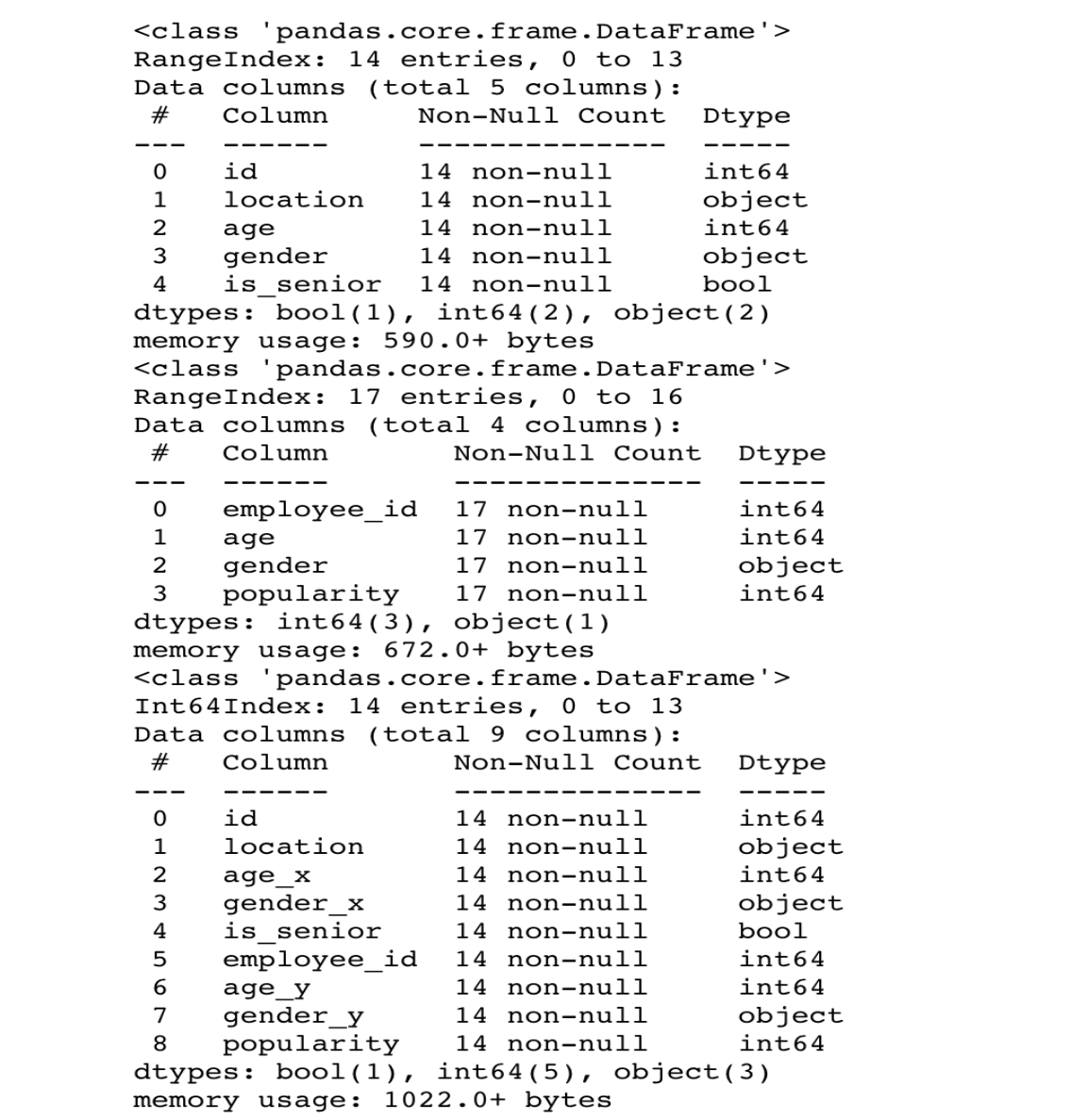Types of Pandas Joins and How to use them in Python

Categories:
 Written by:
Written by:Nathan Rosidi
Here are different types of pandas joins and how to use them in Python. Inner, Outer, Right, and Left joins are explained with examples from Amazon and Meta.
Pandas is an important Python tool to do data analysis and manipulation. Its typical use is working with data frames while analyzing and manipulating data. While working on different data frames, you can combine them using three different functions in four different ways.
How many Methods for Joining Data Frames are there in Pandas?
There are three types of join functions in Python.
- Merge: It merges two data frames on columns or indices.
- Join: The join() function will join two data frames together on a key column or index.
- Concat: The concat() function bonds two data frames across the rows or columns.
It sounds rather similar, so what is the difference between these three approaches?
Merge() allows you to perform more flexible table joins because it provides you more combinations, yet concat() is less structured. Join() combines data frames on the index but not on columns, yet merge() gives you a chance to specify the column you want to join on.
In our examples, we will use merge() to show you how different types of joins in python work.
What’s the Point of Joins in Pandas?

In simple terms, pandas joins in python are used to combine two data frames. When doing that, you have to specify the type of join. The defined pandas join type specifies how the data frames will be joined.
Now, let’s look at the types of python pandas joins with the merge function.
Types of Pandas Joins in Python?
There are four main types of pandas joins in python, which we will explain in this article.
- Inner
- Outer
- Left
- Right
Here is the official page of the Python Pandas “merge” function, which we will use to join two data frames.
Now, let’s get started with Inner Join.
Inner Join in Python

What is Inner Join in Python?
Inner join in pandas is used to merge two data frames at the intersection. It returns the mutual rows of both.
Inner Join Example
Now, let’s look at the example from the platform. Our Inner Join question from the Meta(Facebook).
Last Updated: March 2020
Meta/Facebook has developed a new programing language called Hack.To measure the popularity of Hack they ran a survey with their employees. The survey included data on previous programing familiarity as well as the number of years of experience, age, gender and most importantly satisfaction with Hack. Due to an error location data was not collected, but your supervisor demands a report showing average popularity of Hack by office location. Luckily the user IDs of employees completing the surveys were stored. Based on the above, find the average popularity of the Hack per office location. Output the location along with the average popularity.
DataFrames
Expected Output Type
pandas.Series
Link to the question: https://platform.stratascratch.com/coding/10061-popularity-of-hack
Data
We have two data frames. Our first data frame is facebook_employees. The table has the following columns. The data preview is shown below.
The second data frame is facebook_hack_survey, and it has the following columns. Also, the data preview is shown below.
Solution Approach
- Let’s load the libraries.
- Now, we have to merge two data frames to find the popularity of the location.
- Since the question wants us to show popularity and location, we will group by two columns, and then we will use the mean() function to find the average and reset_index() to remove indexes that the groupby() function creates.
Coding
1. Let’s import the NumPy and Pandas libraries first to manipulate the data and use the statistical methods with it.
import pandas as pd
import numpy as np
If you want to know how to import pandas as pd in python and its importance for doing data science, check out our article “How to Import Pandas as pd in Python”.
2. Now, question asks us to return to a location with popularity.
We have the location in the first data frame and the popularity in our second data frame. So to draw popularity and location together, let’s merge two data frames using the inner join on id. The age and gender columns are in common, yet the id column has a different name in both data frames. That's why we matched the left_on argument with id and the right_on argument with employee_id.
We want to find the popularity of the Hack per office location. So the location and the popularity should match, that’s why we need the intersection, so we will use inner join.
Selecting the right python join type is crucial to get the correct answer. In this case, the left and inner join will return the same result. They will both return 14 rows, which are the commons of both tables.
Yet, the right join will return the whole right data frame, which contains 17 rows, and for the rest, there will be NA assigned on the left data frame.
Below is the info table of three data frames to see the information of the rows of the first, the second, and the merged data frames.

OK, let’s get back to writing the answer using the inner join.
import pandas as pd
import numpy as np
merged = pd.merge(facebook_employees,facebook_hack_survey, left_on = 'id', right_on = 'employee_id', how = 'inner')
3. The question wants us to return the average popularity based on the location, so let’s use the groupby() function with mean() and reset indexes that groupby() creates using the reset_index() method.
import pandas as pd
import numpy as np
merged = pd.merge(facebook_employees,facebook_hack_survey, left_on = 'id', right_on = 'employee_id', how = 'inner')
result = merged.groupby(['location'])['popularity'].mean().reset_index()Output
Here is the output, the average popularity based on the locations.
By the way, if you want to learn more about Pandas, here are Pandas Interview Questions for Data Science.
Outer Join in Python

What is Outer Join in Python?
It might also be called Full Outer Join and returns all rows from both DataFrames. It will match all rows that exist in both data frames. The rows found only in one of the two DataFrames will get the NA value.
Outer Join Example
Now, let’s look at an example of Outer join from the platform.
An app has product features that help guide users through a marketing funnel. Each user may complete some or all steps of a feature. For each feature, calculate the average completion percentage across users, where a user's completion percentage is defined as their maximum step reached divided by the total number of steps (n_steps) for that feature, multiplied by 100.
DataFrames
Expected Output Type
pandas.DataFrame
Link to the question: https://platform.stratascratch.com/coding/9792-user-feature-completion
Data
We have two data frames. Our first data frame is facebook_product_features. The data frame has the following columns. Also, the data preview is shown below.
The second data frame is facebook_product_features_realizations with the following columns. The data preview is shown below.
Solution Approach
- Load the pandas library.
- Group by the feature_id and user id, and calculate the max step reached.
- Merge two data frames on feature_id using the outer join and fill NAs with zero.
- Calculate the share of completion by dividing the step reached with n_step times 100 to find the percentage.
- Group the data frame by feature_id and select the share of completion, calculate the mean, reset the index, and save the results to frame.
Coding
1. Let’s import the pandas library first to manipulate the data.
import pandas as pd2. Now here is the time to find the maximum step by grouping by the feature_id and user_id first. Then select the step reached and use the max() function afterward. After that, we will reset the index that the groupby() function creates.
import pandas as pd
max_step = facebook_product_features_realizations.groupby(["feature_id", "user_id"])[
"step_reached"].max().reset_index()
3. Next, we have to calculate the share of completion. We will divide the step reached by n_steps and multiply by 100. So we have to select n_steps from the first data frame and step_reached from the second data frame. We will combine them on feature_id using the outer join because we need all values from both data frames to do the math. The non-matching values will be NA, so we will replace these values with zero after merging.
import pandas as pd
max_step = facebook_product_features_realizations.groupby(["feature_id", "user_id"])[
"step_reached"].max().reset_index()
df = pd.merge(facebook_product_features, max_step, how='outer', on='feature_id').fillna(0)
4. At this stage, we will calculate the share of completion by dividing the step reached by the number of steps and multiplying by 100.
import pandas as pd
max_step = facebook_product_features_realizations.groupby(["feature_id", "user_id"])[
"step_reached"].max().reset_index()
df = pd.merge(facebook_product_features, max_step, how='outer', on='feature_id').fillna(0)
df["share_of_completion"] = (df["step_reached"] / df["n_steps"])*100
5. Now, we will group by the data frame by feature_id, select the share of completion and calculate the mean. Then we will assign these results to the column avg_share_of_completion and reset the index.
import pandas as pd
max_step = facebook_product_features_realizations.groupby(["feature_id", "user_id"])[
"step_reached"].max().reset_index()
df = pd.merge(facebook_product_features, max_step, how='outer', on='feature_id').fillna(0)
df["share_of_completion"] = (df["step_reached"] / df["n_steps"])*100
result = df.groupby("feature_id")["share_of_completion"].mean().to_frame("avg_share_of_completion").reset_index()
Output
Here is the expected output.
If you want to enhance your Python skills, here are Python Interview Questions and Answers.
Left Outer Join in Python

What is Left Outer Join in Python?
The left outer join returns all rows from the left data frame, which will be merged with the corresponding rows from the right data frame. It fills the unmatched rows with NA.
Left Outer Join Example
This time, our coding question is from Amazon.
Amazon asks us to sort records based on the customer's first name and the order details in ascending order.
Last Updated: April 2019
Find the details of each customer regardless of whether the customer made an order. Output the customer's first name, last name, and the city along with the order details. Sort records based on the customer's first name and the order details in ascending order.
DataFrames
Expected Output Type
pandas.DataFrame
Link to the question: https://platform.stratascratch.com/coding/9891-customer-details
Data
We have two data frames. The first data frame is customers. The data frame has the following columns. The data preview is shown below.
Our second data frame is orders. The data frame has the following columns. Also, the data preview is shown below.
Solution Approach
- Let’s load the libraries.
- Merge the data frames from the left on id and cust_id.
- Sort values by the first names and order details and show first_name, last_name, city, and order_details in the output.
Coding
1. Now first, let’s import pandas and NumPy libraries.
import pandas as pd
import numpy as np
2. Here, we will merge both data frames using the left join because the output should contain the sorted records based on the customer's first name and the order details. We need the list of all customers.
import pandas as pd
import numpy as np
merged = pd.merge(customers, orders, left_on = 'id', right_on = 'cust_id', how = 'left')
3. It is time to sort values according to the first name and order details and select the first name, last name, city, and order details.
import pandas as pd
import numpy as np
merged = pd.merge(customers, orders, left_on = 'id', right_on = 'cust_id', how = 'left')
result = merged[['first_name','last_name','city','order_details']].sort_values(['first_name','order_details'])Output
Here is the expected output.
Right Outer Join in Python

What is Right Outer Join in Python?
The right outer join returns all rows from the right data frame and the remaining data from the left. The data which does not correspond to the right data frame will have NAs assigned.
Right Outer Join Example
This question is from Amazon.
Amazon asks us to find the number of customers without an order.
Find the number of customers without an order.
DataFrames
Link to the question: https://platform.stratascratch.com/coding/10089-find-the-number-of-customers-without-an-order
Data
We have two data frames. The data frame has the following columns. Here is the preview of the data.
The second data frame is customers. The data frame has the following columns. Also, here is the preview.
Solution Approach
- First, let’s load the libraries.
- Merge two data frames from the right.
- Find the customers without an order by using the is_null() method.
- Find the number of customers without an order by using the len() method.
Coding
1. Let’s import the NumPy and pandas libraries first to manipulate the data and use the statistical methods with it.
import pandas as pd
import numpy as np
2. Now, we will merge these two data frames from the right to find the number of customers without an order. After merging two data frames from the right, the customer's order data column will be null if there’s no order. And we can find the customers who haven’t had any orders in the next step.
import pandas as pd
import numpy as np
merged = pd.merge(orders,customers,left_on='cust_id',right_on='id',how='right')3. Here we will use the isnull() function to find the customer ids that don't have any orders.
import pandas as pd
import numpy as np
merged = pd.merge(orders,customers,left_on='cust_id',right_on='id',how='right')
null_cust = merged[merged['cust_id'].isnull()]
4. By using the len() function, we find the number of customers that have not had any orders.
import pandas as pd
import numpy as np
merged = pd.merge(orders,customers,left_on='cust_id',right_on='id',how='right')
null_cust = merged[merged['cust_id'].isnull()]
result = len(null_cust)
Output
Here is the expected output.
If you want to discover the join in SQL too, here are Different Types of SQL JOINs.
Conclusion
In this article, you learned about four pandas joins in python through the interview questions by the companies like Meta and Amazon. These questions showed you how to use the joins in python and, more specifically, where to use them while doing data manipulation step by step.
Practicing similar interview questions will keep you ready for interviews. You should turn it into a habit. So join the StrataScratch community and sign up today to help us find your dream job.
Share


